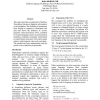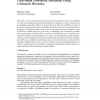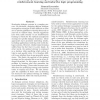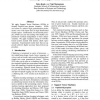NAACL
2001
13 years 5 months ago
2001
NAACL
2001
13 years 5 months ago
2001
In automatic speech recognition (ASR) enabled applications for medical dictations, corpora of literal transcriptions of speech are critical for training both speaker independent a...
NAACL
2001
13 years 5 months ago
2001
This paper describes an approach to Machine Translation that places linguistic information at its foundation. The difficulty of translation from English to Japanese is illustrated...
NAACL
2001
13 years 5 months ago
2001
NAACL
2001
13 years 5 months ago
2001
We present a simple architecture for parsing transcribed speech in which an edited-word detector first removes such words from the sentence string, and then a standard statistical...
NAACL
2001
13 years 5 months ago
2001
We present two methods for learning the structure of personal names from unlabeled data. The first simply uses a few implicit constraints governing this structure to gain a toehol...
NAACL
2001
13 years 5 months ago
2001
NAACL
2001
13 years 5 months ago
2001
Developing dialogue systems is a complex process. In particular, designing efficient dialogue management strategies is often difficult as there are no precise guidelines to develo...
NAACL
2001
13 years 5 months ago
2001
In this paper we investigate polysemous adjectives whose meaning varies depending on the nouns they modify (e.g., fast). We acquire the meanings of these adjectives from a large c...
NAACL
2001
13 years 5 months ago
2001
We apply Support Vector Machines (SVMs) to identify English base phrases (chunks). SVMs are known to achieve high generalization performance even with input data of high dimension...




